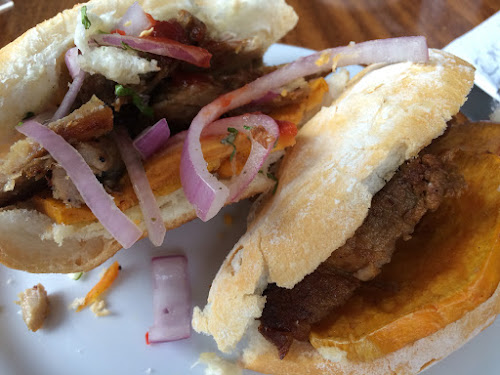Chivay is upstream from the Colca Canyon which we will visit tomorrow. Another early start.
We go to 4900 m today! We will test the Diamox medication which we have been taking for a few days now. Our tour comprises 12 people - we are known as Las Dos Pamelas or The Two Pamelas. This intro has the effect of 'bringing the house down' - or at least, producing great guffaws of laughter; we tend not to be forgotten or our names aren't anyway.
We follow the railway from Arequipa to Puno - it is not used for passengers anymore; it is used for mining.
The road climbs and twists - and the number of trucks our mini-bus had to overtake was a testament to the skill of our driver Miguel.
Surrounding us are several volcanos - all with snow. We see the Ampato volcano where 'Juanita the Ice Maiden' was discovered preserved perfectly in the ice.
We enter the national park: La Reserva Nacional Salinas y Aguada Blanca. Lovely country: lots of volcanic rock, cacti and some lovely greeny yellow pampas grasses.
There are 4 camelids in this NP: llama, vicuña, guanaco, alpaca. We get to see a bunch of vicuñas AND a train goes past scaring the things back across the road so we watched in horror hoping the trucks wouldn't mow them down! Chaccu the Peruvian version of a rodeo takes place in August: the local Indian people who live in the NP herd the vicuña to shear them for the fibre. The fibre is very fine and is used to make the most expensive garments.
We get to an intersection, where the road splits and one goes off off to Cusco. We are now at 4000 m and we feel surprisingly fine.
We stop here for a break and try Mate Inca - a special coca tea comprising coca, muña (Andean mint), chachacoma. Coca has 14 alkaloids good for altitude sickness (known as soreche locally). There are many alpacas here.
On the bus when we leave our stop, we try chewing coca leaves with a small piece of llicda made from quinoa, platanos, ...
We made another stop for llamas and coots and flamingos near the Rio Capillano.
We reach Pata Pampa, 4900m the highest pass in Peru for a view of 3 volcanos - Sabancaya (which is smoking), Ampato, Hualca Hualca. Further away are Misti and Chachani. Definitely notice the altitude here!
Gaudy does a great job as guide - lots of good information and excellent English!
Rock pillars are everywhere and represent offerings to the gods but also nowadays many are made by the tourists.
Am experiencing headache here and a bit of breathlessness which declines as we go start descending but I still need a couple of Panadol later.
We can see the Central Range plus Mismi volcano - which it has been verified is the source of the Amazon River. Approaching Chivay I get tingling of the fingers, a side-effect of the Diamox. Not sure why I am getting it now? But this symptom disappears quickly.
In Chivay we have a huge buffet lunch with many Peruvian foods. Then a walk around the market where Gaudy talks about the local fruits and vegetables - the corn and potato are popular here with many, many different varieties. We try prickly pear. There is a lot of embroidery - and sombreros whose decoration represents which ethnic group the wearer is from.
The locals here have a new 'take' on barbed wire fences! Wouldn't want to tangle with this!!!
They also have some interesting forms of transport to get around town - a new form of hybrd bike?
Then finally to our Colca Lodge. I am feeling sleepy as it is quite hot in the afternoon sun. Our hotel is about half an hour out of Chivay. It is amazing!! What a place!!!
The porters carry the suitcases down - it is quite a way from where our mini-van parks; I feel sorry for them. We have a coca tea (mate de coca) while check-in is processed and then set off to walk around the extensive property, followed by a visit to the alpaca ranch and then an hour soaking in the hot thermal springs.
We cancel dinner at the restaurant and opt for sitting by the fire in the bar area with an Argentinian malbec (breaking the rules about alcohol and altitude) and some bruschetta with local smoked trout and a chicken hamburger from which I remove the bread as it is too much.
TOP's shower was lukewarm; I was expecting a so-so one and so, on finding the water hot, decided on a whim to wash my hair. In the fog of the bathroom I selected the shampoo OK but inadvertently got hand cream instead of conditioner - interesting! Now why would you put two shampoos, one conditioner and one hand cream in the toiletries basket? Why not two conditioners? But what are your chances?!
































































